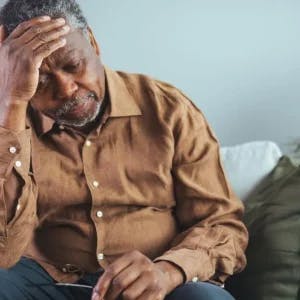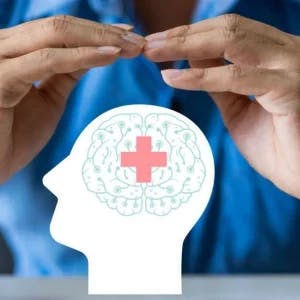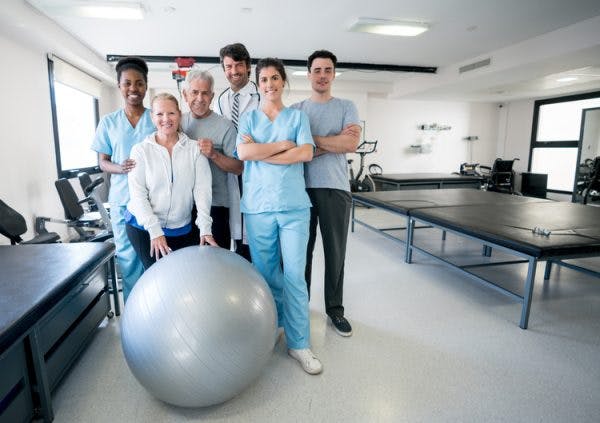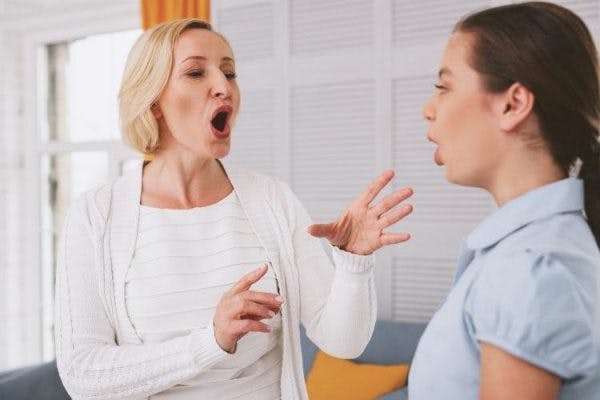More than 1/3 of survivors deal with post-stroke depression at any one time. Knowing that over 795,000 people experience strokes every year in the US, that statistic is staggering. Post-stroke depression is often related to the major changes in everyday life as a result of a stroke and the accompanying secondary effects.
This emotional effect of stroke can have a major impact on a survivor and/or their caregiver’s quality of life. Thankfully, there are a variety of different treatments available for survivors to help manage post-stroke depression. While some survivors may require medication to manage depression symptoms, other approaches may also be beneficial during recovery.
Most importantly, survivors need to seek support if they are experiencing depression after stroke. To help you get started, this article will examine the different causes of post-stroke depression. Then we will review the treatments available to survivors to help manage and overcome depression symptoms.
The Main Causes of Post-Stroke Depression
The causes of post-stroke depression vary from person to person and are often due to a combination of factors rather than just one. Some of the causes of depression after stroke include:
1. Changes to the Brain
There are two main types of stroke. One type is ischemic stroke (caused by blockage of a vessel) and the other is hemorrhagic stroke (caused when a vessel bursts). Both types cause an interruption of the brain’s normal blood flow and result in tissue damage. This can lead to a wide variety of stroke secondary effects depending on the area of the brain that is impacted.
While ischemic stroke is more common than hemorrhagic stroke, either type can result in post-stroke depression. This can be attributed to physical changes within the brain, specifically in the areas responsible for emotions and mood. One example is the frontal lobe, which helps regulate emotions, decision-making, and judgment.
In addition to tissue damage within these areas of the brain, other chemical changes occur after stroke that can contribute to the development of depression. This includes the presence of inflammation in the brain after stroke as well as changes in the blood-brain barrier.
2. Thought Patterns
Since a stroke is often followed by major changes in daily life, this can cause a survivor and caregiver to experience a range of difficult emotions. For example, many survivors and their loved ones experience different stages of grief after stroke due to these life changes. This can be related to the loss of physical abilities, independence, or beloved hobbies.
Depending on the location of the stroke, a survivor may have difficulty processing negative thought patterns. Additionally, many survivors experience other behavioral changes such as emotional lability. When a survivor’s situation seems hopeless or dramatically different than they had pictured, this can contribute to negative thought patterns. When these thought patterns remain unchecked, this can create a slippery slope and snowball into depression.
3. Lifestyle and Social Changes
Stroke often results in changes in physical abilities. These physical changes can cause a survivor to temporarily or even permanently lose deeply personal hobbies. For example, a survivor affected by hemiparesis or hemiplegia may be unable to play the guitar or paint due to arm weakness or paralysis.
Additionally, there is often a change in social involvement following stroke. Attending social gatherings may be difficult due to transportation or mobility challenges. Since humans are social creatures who crave connection, this loss of social involvement can negatively impact mental and emotional health, often contributing to depression.
All these factors, among others, can accumulate following a stroke and lead to post-stroke depression for survivors. Furthermore, caregivers often experience depression at equal or even greater rates as they undergo similar changes to their lifestyle or independence. While there is no one-size-fits-all treatment, the rest of this article will look into different treatments and techniques to navigate depression after stroke.
Treating Post-Stroke Depression
If you are experiencing post-stroke depression, it is vital to seek help to improve your mental and emotional well-being. Depression after stroke is correlated with poorer functional outcomes and higher morbidity. Additionally, this can negatively affect your motivation and compliance with rehabilitation exercises.
Seeking treatment for post-stroke depression is necessary to improve your mental and emotional health. Furthermore, this can help you boost your physical recovery and motivation to continue your therapy exercises. To help you get started, let’s review some different methods for managing post-stroke depression.
Pursue Psychological Treatment
Seeking help from a licensed therapist or counselor can be a valuable resource for both survivors and their caregivers. Participating in psychological care, such as cognitive-behavioral therapy, can help you identify negative thought patterns and behaviors you may be experiencing after stroke.
A therapist can provide you with different tools and techniques to allow you to better manage post-stroke depression. Additionally, they can provide tips to help you communicate with your loved ones to maintain healthy relationships. Changing the way you view your recovery can help you stay focused on rehabilitation and improve your mental health and overall quality of life.
Find an Outlet
After stroke, many survivors experience changes in their physical abilities that can prevent them from participating in previous activities or hobbies. However, it is important to find activities that you enjoy and can participate in after stroke.
Spend some time thinking about what you enjoy and then pursue a new hobby that matches your interests. This might include hobbies like listening to audiobooks, painting, photography, or birdwatching. Hobbies such as puzzles or brain teasers can also help sharpen your cognitive skills.
Additionally, think about ways you can modify your normal hobbies to meet your current needs. For example, if you previously enjoyed large-scale gardening, try gardening using raised beds or pots that you can access more easily. Talk with your physical or occupational therapist about ways to make your hobbies more accessible.
Talk to Your Doctor
If you are experiencing ongoing symptoms of depression such as a loss of interest in your daily activities, speak with your doctor about your symptoms. They can help understand and diagnose your symptoms and provide appropriate treatment.
In addition to connecting you with psychological care, your doctor may prescribe medication that can treat your depression symptoms. Antidepressants such as SSRIs can help regulate the chemicals in your brain and reduce depression symptoms over time. For some individuals, this can be an incredibly helpful tool to boost recovery and improve quality of life.
Create Health Habits
Your mental and emotional health may experience major changes after stroke. However, there are specific habits and behaviors you can control in your daily life to maximize your health and recovery. Habits like maintaining a healthy diet and practicing good sleep hygiene can improve your cognitive function and reduce post-stroke depression symptoms.
Eating foods that help boost stroke recovery has been shown to lessen the severity of depression symptoms. For example, the foods you eat can directly affect your level of serotonin, which helps regulate your mood. A diet focused on fresh vegetables and fruits, lean protein, and healthy fatty acids can provide the brain with the nutrients it needs to heal after stroke. Additionally, many of these foods are high in BDNF (brain-derived neurotrophic factor), which can help promote neuroplasticity.
Sleep is another important piece of the recovery puzzle. Sleep disturbances, which are common after stroke, have a direct link with depression. For this reason, it is important to practice healthy sleep habits to increase your amount of restful sleep and improve your physical and mental health. Some examples of good sleep habits include setting a consistent bedtime routine, creating a calm bedroom environment, and limiting caffeine intake.
Exercise!
One more healthy habit that is necessary for stroke recovery is regular exercise. Not only does this promote physical recovery after stroke, but exercise has also been shown to reduce depressive symptoms for stroke survivors. While this may seem daunting at first, exercise after stroke can be tailored to fit every survivor’s individual needs and abilities.
Ask your physical and occupational therapists to help you create a home exercise program that allows you to work toward your unique goals. In addition to seeing gains in muscle strength and physical function, participating in regular exercise after stroke can produce endorphins and also reduce the risk of a second stroke.
Next, we will discuss another powerful tool for managing post-stroke depression symptoms. This tool, known as positive psychology, is accessible to everyone and can have an impact on many aspects of recovery for both survivors and caregivers.
Using Positive Psychology to Reduce Post-Stroke Depression
While some emotional symptoms occur due to the biological impact of stroke, others occur because of drastic changes in lifestyle or independence. For many survivors, it feels like life gets turned upside down. To help you manage these feelings and depression symptoms, the emerging field of positive psychology offers useful practices.
Positive psychology is the study of creating positive feelings like gratitude, compassion, and happiness. This is closely tied to neuroplasticity, which is your brain’s ability to heal through the creation of new neural pathways.
A popular book on positive psychology called Hardwiring Happiness talks about how to use neuroplasticity to rewire your brain for happiness. To boost neuroplasticity, your brain requires high repetitions to promote this re-learning of functions. This does not just apply to physical exercises, but also to mental exercises like positive psychology.
To summarize this concept, the basic premise of neuroplasticity is that your brain becomes better at what you repeatedly practice. The more you practice focusing on the good, the more you will notice the good that still exists in your life, even when things seem otherwise. Try practicing these positive psychology techniques to help manage post-stroke depression:
- Create a gratitude journal. Try writing down at least three things you are grateful for each day. This can help you focus on the positive aspects of your recovery, track your progress, and improve your outlook as you pursue rehabilitation.
- Concentrate on your strengths. After stroke, it can be easy to focus solely on the negative physical and emotional effects you are experiencing. However, finding your strengths and using those to the best of your ability can improve your feelings of independence and accomplishment.
- Find helpful resources. Some survivors can practice positive psychology and improve their emotional well-being by finding new books or resources. For example, Healing & Happiness After Stroke was written specifically for stroke survivors who want extra support with the emotional side of recovery.
Post-Stroke Depression Management
After a stroke, a large percentage of survivors will experience post-stroke depression. This can have a major impact on both survivors and caregivers and can also have negative implications for recovery. However, you are not alone and there are resources available to help you manage your symptoms.
Talking to your doctor and seeking psychological treatment can be valuable steps toward recovery from post-stroke depression. There are also specific changes to your daily routine that can help treat or reduce your symptoms. This includes prioritizing a healthy diet, getting daily exercise, and practicing good sleep habits.
In addition, learning about positive psychology may help you along your road to recovery. Try focusing on your progress and working to create positive thought patterns to boost your mental health and well-being. While post-stroke depression may be common, it should be taken seriously. Seek support from those around you and, above all, never stop working toward recovery.















